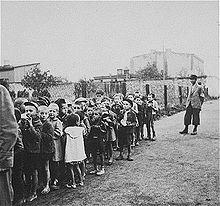Judenrat
Judenrat (plural: Judenräte; 'Jewish assembly' in German) is the name they received the Jewish governing councils of the ghettos established by the Nazis in various places, and especially in the territory of the General Government of Poland, the part of Poland occupied but not annexed by Germany.
They had different names depending on the specific Judenrat in question. For its formation, the Nazis located a prominent Jew, usually some former elected official, a president of a Jewish association or a rabbi, and commissioned him to form the council. This was made up of twelve members in ghettos with fewer than 10,000 inhabitants and twenty-four if they exceeded that number. The Nazi-appointed presidents called on other former Jewish leaders to serve on the council, although they were generally careful to exclude people who might irritate the Germans: Orthodox, Communist or Socialist rabbis, among others. The Judenräte were in charge of the entire population of a ghetto, having to maintain order (through their own police forces, the Jewish Police) and comply with and enforce German guidelines. In this way, the Jewish councils were the ones that took a census of the Jewish population, inventoried their assets to facilitate their confiscation by the Nazis, drew up the lists of people who should be deported to the extermination camps, led them to the boarding places and They chased those who fled or hid. In general, they complied punctually and zealously with the instructions received, since the members of the Judenrat were personally responsible for any negligence or disobedience, and especially their president, appointed as has been said directly by the Germans, who he received instructions from an SS officer in charge of the ghetto.
The Jewish councils were an essential piece in the mechanism of the Holocaust, so their work -on which there is abundant documentation- has aroused much controversy in subsequent historiography. Current researchers agree in pointing out the ability of the Nazis to place the bulk of the tasks that led to the extermination of the Jews in the camps on the Jews themselves (in the camps, the Sonderkommandos who were in charge of the physical elimination of the prisoners and their incineration), and there is also agreement in concluding that without this forced collaboration, it would probably have been an infinitely more difficult task. The obscure point of the question is how such diligent collaboration came to be. The people who made up the Judenräte enjoyed temporary immunity from deportation and their behavior may have been influenced by the fact that the decisions that led to the death of Jews were made gradually, so that when the ghettos were formed in 1939, no one, not even the Nazis themselves (except perhaps the highest leaders), could have supposed that finally (in 1942) they would opt for total extermination. Initially it was thought that the ghettos were the step prior to the resettlement of Jews outside the borders of the Reich (and in fact, resettlement was the word that was used in official documents even when it was about the transfer to the death camps). When the extermination operations began, the Judenräte continued to cooperate with the Nazis, apparently, according to the accounts of the few survivors, initially convinced that the slaughter could not last long and that by sacrificing a part of the Jews the rest could be saved; As the Final Solution dragged on over time, however, they continued to collaborate in order to delay their own deportation and that of their relatives, although in the end they did not even achieve the latter.
In some places, such as the Minsk Ghetto, the Judenrat collaborated with the underground Jewish resistance.
Chaim Rumkowski (1877-1944) is perhaps the best known member of a Judenrat. He ruled the Lodz ghetto (Poland) as a dictator, was an active collaborator with the Nazis and surrounded himself with royal pomp, calling himself Chaim I. Expressions such as "my Jews", " 34;my ghetto", "my factories". He died in the Auschwitz gas chambers.
Another famous Jewish leader was Adam Czerniaków (1880-1942), president of the Warsaw ghetto. When the Nazis ordered him to prepare a deportation of several thousand people, he committed suicide. He left a diary.
Contenido relacionado
Battle of Raszyn
Ignacio Carrera Pinto
Nanjing massacre
Tirpitz (1941)
Adrian von Renteln
